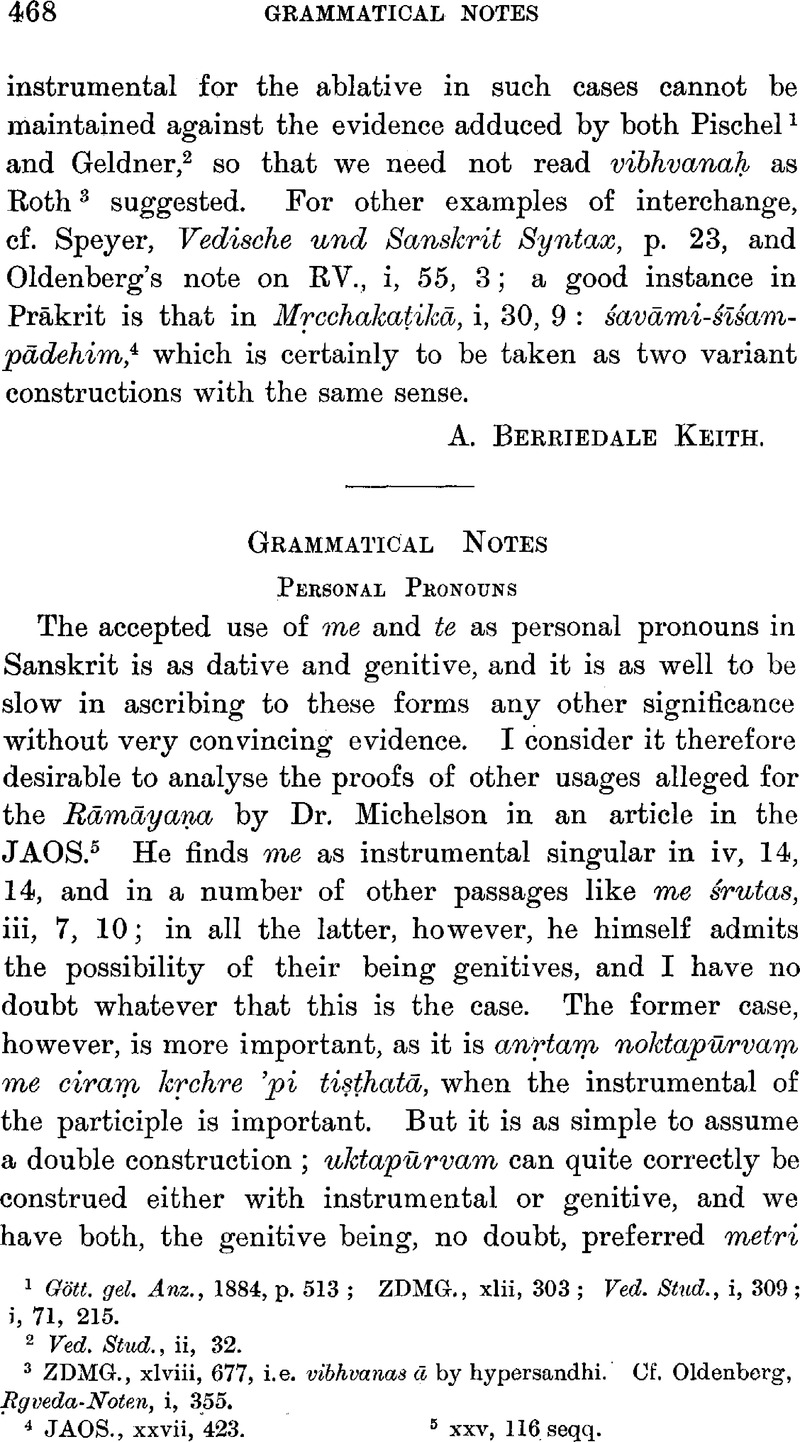No CrossRef data available.
Article contents
Abstract

- Type
- Miscellaneous Communications
- Information
- Copyright
- Copyright © The Royal Asiatic Society 1910
References
page 468 note 5 xxv, 116 seqq.
page 469 note 1 Böhtlingk, ZDMG., xli, 187.
page 469 note 2 JAOS., xxv, 107. Cf. also AV., x, 7, 39, as explained by Hopkins, , JAOS., xxviii, 367, n. 1Google Scholar, and RV., i, 31, 12, as explained by Pisehel, , Ved. Stud., iii, 193Google Scholar; and cf. the citation from the Bower MS. in Hoernle's paper, Ind. Ant., xxi, 352.
page 469 note 3 Cf. JRAS., 1906, pp. 722, 993; 1909, p. 155, n. 6. For the genitive with participle, cf. Caland, , Über das rituelle Sūtra des Baudhāyana, pp. 45, 46Google Scholar; Delbrück, , Synt. Forsch., v, 153Google Scholar.
page 469 note 4 Monro, , Homeric Grammar, p. 135, 136Google Scholar.
page 470 note 1 JAOS., xx, 222. Cf. JAOS., xxviii, 388, n. 1, where he suggests that te in the Epic śape te is accusative, but the dative is perfectly plausible, cf. Śatapatha Brāhmaṇa, xii, 7, 3, 1.
page 470 note 2 Contrast the same dative but in a contrary sense; Mbh., iii, 279, 4: na hi me mokṣyase jīvan, and 282, 16: na me mokṣyase karhicit, where on Mr. Michelson's principle we would equate the dative and the genitive.
page 470 note 3 It is worth noting that Franke, (Die Casuslehre des Pāṇini, pp. 20, 21)Google Scholar suggests that in similar cases the dative is original and the genitive is due to the popular dialects. But this is hardly necessary as the genitive is naturally found adnominally with gerunds and participles. The use, however, of the dative in Sanskrit confirms Monro's, view (Homeric Grammar, p. 136)Google Scholar that its use in Greek was not instrumental in origin: cf. also Delbrück, , Vergl. Synt., i, 300Google Scholar; Hopkins, , JAOS., xxviii, 371–4Google Scholar.
page 471 note 1 Cf. Delbrück, , Synt. Forsch., v, 146, 147Google Scholar, and perhaps in RV., i, 34, 7, sūre duhitā (contra Pischel, , Ved. Stud., iii, 192Google Scholar, and cf. Oldenberg, , Ṛgveda-Noten, i, 37)Google Scholar; Whitney, , Sanskrit Grammar, p. 96Google Scholar, does not illustrate this use, and Speyer, , Vedisch und Sanskrit Syntax, p. 14Google Scholar, regards them as genitive in use.
page 471 note 2 How far he meant his interpretations to represent his views on Syntax one cannot say.
page 471 note 3 Hopkins, , JAOS., xx, 28Google Scholar.
page 471 note 4 JAOS., xxv, 119.
page 471 note 5 Ibid., 112.
page 472 note 1 Cf. Speyer, , Vedische und Sanskrit Syntax, p. 67 and reff.Google Scholar; St. Petersburg Dictionary, vii, 22; Bollensen's ed., p. 227.
page 472 note 2 Ind. Ant., xxi, 352, 355. Cf. Senart, ibid., p. 6.
page 472 note 3 ZDMG., xxxv, 714 seqq.; Ved. Stud., i, p. xxxi, n. 2. Cf. Delbrück, , Synt. Forsch., v, 205Google Scholar.
page 473 note 1 Oldenberg takes te as the indirect object in this passage.
page 473 note 2 Oldenberg here takes ta as dependent on ajara.
page 473 note 3 See also Oldenberg, SBE., xlvi, 394.
page 474 note 1 p. 104.
page 474 note 2 The Ṛgvedic passages have all been dealt with by Oldenberg, in his Ṛgveda-Noten, i, 25–9Google Scholar, who appears to accept the use of te as accusative in the Epic on the strength of Hopkins', remark in JAOS., xx, 222Google Scholar; see Oldenberg, p. 25, n. 2. The explanations given of the passages in question in this article, written before the appearance of Oldenberg's book, differ somewhat from and are perhaps inferior to those given by him, but they agree in rejecting the theory of te as accusative.


